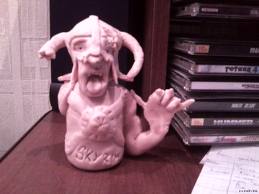[NH3] = .096 M , [MgCl2] = .038 M, How many grams of (NH3)2SO4 should be present to prevent precipitation of Mg(OH)2? The Ksp of Mg(OH)2 is 1.8 x 10–11.
6 posts
• Page 1 of 1
Chemistry Question (Ksp stuff)
[NH3] = .096 M , [MgCl2] = .038 M, How many grams of (NH3)2SO4 should be present to prevent precipitation of Mg(OH)2? The Ksp of Mg(OH)2 is 1.8 x 10–11.
-

Melly Angelic - Posts: 3461
- Joined: Wed Aug 15, 2007 7:58 am
Gimme a sec, and I'll try to type out how to solve it.
I'm pretty sure you need to post the volumes of NH3 and MgCl2 first though . . .
-

Jacob Phillips - Posts: 3430
- Joined: Tue Aug 14, 2007 9:46 am
Stolzfus?
Gimme a sec, and I'll try to type out how to solve it.
I'm pretty sure you need to post the volumes of NH3 and MgCl2 first though . . .
Gimme a sec, and I'll try to type out how to solve it.
I'm pretty sure you need to post the volumes of NH3 and MgCl2 first though . . .
Yup haha... It's cool to find another Buckeye on the forums.
And NH3=.35 L , .14 M
MgCl2 = .16 L , .12 M
-

jessica breen - Posts: 3524
- Joined: Thu Aug 03, 2006 1:04 am
Here we go:
Ksp = [Mg2+][OH-]^2
plug in what you know . . .
1.8x10^-11 = [0.96][x]^2
solve for x . . .
x = [OH-] = 2.176x10^-5
x is the concentration of OH- at which precipitation will begin, you want to keep the pH low enough to prevent this
Look up the Kb for NH3, it should be about 1.8X10^-5
then set up the expression Kb = [NH4+][OH-]/[NH3]
which come from the equation NH3 (aq) + H2O (l) <----> NH4+ (aq) + OH- (aq) which we can complete an ice table for
----------------------------------I 0.096, y, 0
----------------------------------C -x, +x, +x,
----------------------------------E 0.096-x, y+ x, 0+x,
The X is the amount of hydroxide in the system as it reaches equilibrium, while NH4 is the amount of ammonium which results from adding the (NH4)2SO4. Basically we are calculating as if the resulting buffered solution was already created and it is just reaching equilibrium. Y is what we're solving for, because we already know what we want X to be based on our previously calculated [OH-]. You can find Kb for ammonia in your book, it is 1.8x10^-5.
So . . . from the Kb expression: 1.8x10^-5=[y+x][x]/[0.096-x]
plug in x = 2.176x10^-5 and solve for y
You should get roughly y=0.07936 M NH4+
You divide this by 2 since there are 2 moles NH4+ per 1 mole (NH4)2SO4
Multiply the resulting molarity times your total liters of solution, then times the molar mass of (NH4)2SO4 and you should be set. Let me know what you get. You might also want to calculate your original molarities a bit more accurately first. I can't promise you'll get the right answer if you only keep two digits like the concentrations you originally posted.
Edit: ICE table didn't format right, fighting with it now. Forums won't let me put a bunch of spaces for the sake of alignment, so just realize that the comma separated values correspond to the concentrations of aqueous particles in the order they are listed above ([NH3], [NH4+], [OH-])
Ksp = [Mg2+][OH-]^2
plug in what you know . . .
1.8x10^-11 = [0.96][x]^2
solve for x . . .
x = [OH-] = 2.176x10^-5
x is the concentration of OH- at which precipitation will begin, you want to keep the pH low enough to prevent this
Look up the Kb for NH3, it should be about 1.8X10^-5
then set up the expression Kb = [NH4+][OH-]/[NH3]
which come from the equation NH3 (aq) + H2O (l) <----> NH4+ (aq) + OH- (aq) which we can complete an ice table for
----------------------------------I 0.096, y, 0
----------------------------------C -x, +x, +x,
----------------------------------E 0.096-x, y+ x, 0+x,
The X is the amount of hydroxide in the system as it reaches equilibrium, while NH4 is the amount of ammonium which results from adding the (NH4)2SO4. Basically we are calculating as if the resulting buffered solution was already created and it is just reaching equilibrium. Y is what we're solving for, because we already know what we want X to be based on our previously calculated [OH-]. You can find Kb for ammonia in your book, it is 1.8x10^-5.
So . . . from the Kb expression: 1.8x10^-5=[y+x][x]/[0.096-x]
plug in x = 2.176x10^-5 and solve for y
You should get roughly y=0.07936 M NH4+
You divide this by 2 since there are 2 moles NH4+ per 1 mole (NH4)2SO4
Multiply the resulting molarity times your total liters of solution, then times the molar mass of (NH4)2SO4 and you should be set. Let me know what you get. You might also want to calculate your original molarities a bit more accurately first. I can't promise you'll get the right answer if you only keep two digits like the concentrations you originally posted.
Edit: ICE table didn't format right, fighting with it now. Forums won't let me put a bunch of spaces for the sake of alignment, so just realize that the comma separated values correspond to the concentrations of aqueous particles in the order they are listed above ([NH3], [NH4+], [OH-])
-

sarah taylor - Posts: 3490
- Joined: Thu Nov 16, 2006 3:36 pm
(snip)
HOLY CRAP THAT'S RIGHT.
Dear God, we have a genius on our hands. I might just have to sit next to you in lecture and see if I absorb any of it by osmosis...

Thanks so much for your help. And good explanation too!
-

Rachael Williams - Posts: 3373
- Joined: Tue Aug 01, 2006 6:43 pm
HOLY CRAP THAT'S RIGHT.
Dear God, we have a genius on our hands. I might just have to sit next to you in lecture and see if I absorb any of it by osmosis...
Thanks so much for your help. And good explanation too!
Dear God, we have a genius on our hands. I might just have to sit next to you in lecture and see if I absorb any of it by osmosis...

Thanks so much for your help. And good explanation too!
Haha, glad to help. Took me a while to work that one out too.

-

Katie Louise Ingram - Posts: 3437
- Joined: Sat Nov 18, 2006 2:10 am
6 posts
• Page 1 of 1
